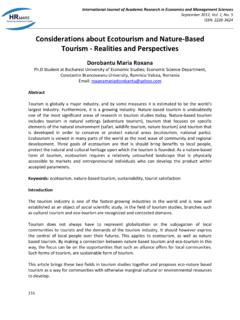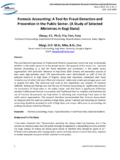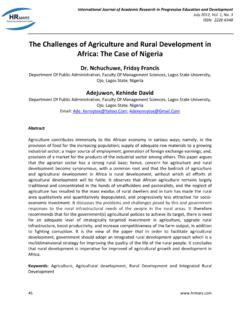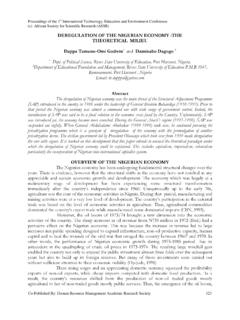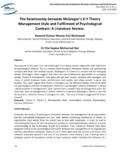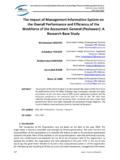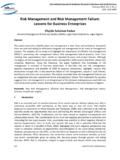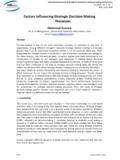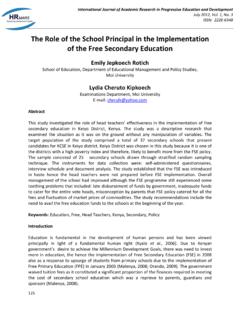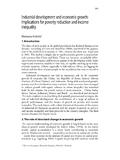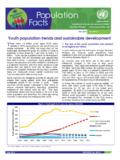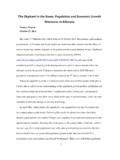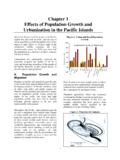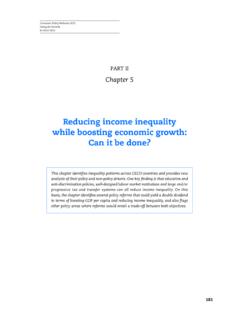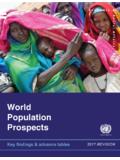Transcription of POPULATION AND ECONOMIC GROWTH IN …
1 International Journal of Academic Research in Business and Social Sciences January 2012, Vol. 2, No. 1 ISSN: 2222-6990 6 POPULATION AND ECONOMIC GROWTH IN DEVELOPING COUNTRIES Minh Quang Dao Professor of Economics, Eastern Illinois University, 600 E. Lincoln Avenue Charleston, IL 61920, Email: ABSTRACT Purpose: This paper examines the ECONOMIC effects of the demographic transition in developing countries. Findings: Based on data from the World Bank and using a sample of forty-three developing economies, we find that the GROWTH rate of per capita GDP is linearly dependent upon POPULATION GROWTH , both the young and old dependency ratios, the mortality rate, and whether or not the rate of POPULATION GROWTH is less than percent per year. Using interaction variables in light of the severe degree of multicollinearity among explanatory variables, we find that per capita GDP GROWTH linearly depends on POPULATION GROWTH , the old dependency ratio, the mortality rate, and the interactions between POPULATION GROWTH and both the young and old dependency ratios, between POPULATION GROWTH and whether or not the rate of POPULATION GROWTH is less than percent per year, and the interaction term between the young dependency ratio and whether or not the rate of POPULATION GROWTH is less than percent per year.
2 Practical Implications: Statistical results of such an empirical examination will assist governments in devising policies aimed at influencing the ECONOMIC effects of the demographic Methodology/Approach: Data for all variables are from the 2010 World Development Indicators. We apply the least-squares estimation technique in a multivariate linear regression. We also test for the nonlinear effect of POPULATION GROWTH on ECONOMIC GROWTH and note that the introduction of interaction terms between POPULATION GROWTH and dependency ratios as well as those between whether or not the POPULATION GROWTH rate is less than percent and POPULATION GROWTH and the young dependency ratio yields better statistical results. JEL Classifications: O12, O15, O50 Keywords: Demographic Transition, Mortality Decline, POPULATION GROWTH , Dependency Ratios, Developing Countries International Journal of Academic Research in Business and Social Sciences January 2012, Vol.
3 2, No. 1 ISSN: 2222-6990 7 INTRODUCTION Economists have often neglected the impact of fundamental demographic processes on ECONOMIC GROWTH . Bloom and Canning (2001) are among the few who explore the effect of the demographic transition on ECONOMIC GROWTH . They argue that it is possible that the interaction of ECONOMIC GROWTH with POPULATION dynamics can result in a poverty trap. Consider two clubs: one with low income and high POPULATION GROWTH rates, while the other with high income and low POPULATION GROWTH rates. While transition between these clubs may be rare, they are able to show that when it does happen, it does so very quickly, due to the positive feedbacks between GROWTH and the demographic transition. More recently, Dyson (2010) claims that mortality decline aids ECONOMIC GROWTH and hence leads to an increase in the standard of living. As people live longer, they tend to think more about the future and are more likely to take risk and innovate.
4 For instance, Bloom and Canning (2001) and Kalemli-Ozcan (2002) find evidence in developing countries that mortality decline has the tendency to raise educational attainment and savings rates and thus to increase investment in both physical and human capital. Mortality decline is also accompanied by health gains that in turn enhance people s ECONOMIC productivity. Strauss and Thomas (1998), for instance, show that healthier workers are likely to be more productive. In addition to mortality decline, Dyson (2010) has identified POPULATION GROWTH , fertility and age-structural change as well as urban GROWTH /urbanization as demographic factors that affect ECONOMIC GROWTH . The present study empirically examines the impact of the various dimensions of the demographic transition on per capita GDP GROWTH in developing countries. Statistical results of such empirical examination will assist governments in those countries devise policies aimed at influencing the ECONOMIC effects of the demographic transition.
5 Taking into consideration the two-way causality between the dimensions of the transition, we include interaction variables in order to eliminate the simultaneity bias and thus are able to obtain superior statistical results. This paper is organized as follows. In the next section, a selected review of the literature on the ECONOMIC effects of the demographic transition is given. This is followed by the formulation of a statistical model to be estimated. Theoretical underpinnings for the inclusion of explanatory variables are included in this section. Statistical results are reported in the subsequent section. A final section gives concluding remarks as well as policy recommendations. A SELECTED REVIEW OF THE LITERATURE While Dyson (2010) contends that mortality decline is the chief cause of ECONOMIC development, McKeown (1976) argues that the direction of causality should be reversed, , it is the improvement in the standard of living that results in lower death rates.
6 Easterlin (1996) and Schofield and Reher (1991) also show that the dire living conditions that came with the industrial revolution and modern ECONOMIC GROWTH in cities of Europe during the nineteenth century might have raised mortality rates. On the other hand, evidence from contemporary developing economies tends to show that it is mortality decline that leads to ECONOMIC GROWTH , International Journal of Academic Research in Business and Social Sciences January 2012, Vol. 2, No. 1 ISSN: 2222-6990 8 as it increases investment in both physical and human capital via increased savings rates and education (see, for instance Bloom and Canning (2001) and Kalemli-Ozcan (2002). Furthermore, mortality tends to fall as a result of declines in death rates from infectious diseases. Declines in these diseases tend to bring about an improvement in the nutritional status of children which in turn leads to a fitter future labor force.)
7 In fact, Strauss and Thomas (1998) show that healthier workers tend to be more productive. In pre-transitional societies, relatively rapid POPULATION GROWTH almost always resulted in a fall in the standard of living due to the rather severe limits to the technical progress in agriculture or to the fixed supply of land, as pointed out by Malthus (1798; 1830 [1970]). This prompts Clark (2007) to state that income levels before the nineteenth century could not escape the Malthusian equilibrium due to the very low rate of technological advance in all economies. However, according to the neutralist or revisionist view, high POPULATION GROWTH rates in developing countries since the middle of the twentieth century have had little effect on per capita GDP GROWTH (see, for instance, Kuznets (1967), Kelley (1988), and Kelley and McGreevey (1994)). Simon (1981, 1989) would go as far as suggesting that POPULATION GROWTH may have had a positive impact on per capita GDP GROWTH in the long run through improvement of productivity through the contribution of new ideas and the learning-by-doing resulting from increased production volume.
8 Nevertheless, the current consensus is that, as more data become available, rapid POPULATION GROWTH has exerted a significant negative effect on ECONOMIC GROWTH in developing countries (see, for example Birdsall and Sinding (2001), Barro and Sala-i-Martin (2004), Sachs (2008), and Headey and Hodge (2009)). The recent experience of fertility decline in developing countries in Asia and Latin America has reduced a country s dependency ratio, which then raised the potential for faster ECONOMIC GROWTH through higher saving and investment levels in both physical capital (such as roads, production facilities) and human capital (such as higher educational attainment and training for each young worker), particularly for an extended period over which the labor force increases at a faster rate than the pool of dependent people (see, for instance, Higgins and Williamson (1997), Mason (1997), and Bloom and Canning (2001).)
9 Due to this decline, however, eventually this region will experience an increase in its old-age dependency ratio as is the case for both Europe and Japan (see, for instance, Bloom et al. (2009)). POPULATION ageing thus may be exercising a negative impact on ECONOMIC GROWTH . While many problems such as congestion, pollution, and slum settlements are caused by urban GROWTH in contemporary developing countries, cities are often described as engines of GROWTH (see, for example, Jacobs (1972), Crook (1997), and Beall and Fox (2009)). Cities also provide large and concentrated markets, allowing for economies of scale in the production of manufactured goods as well as low transportation costs. It is in urban areas that firms can better match their labor demands with the supply of skills, while the returns to infrastructure such as roads, port facilities, and electricity grids are greater due to the concentration of industries and firms.
10 Fox and Dyson (2008) analyze international data for the period since 1975 and find that urban GROWTH has been positively associated with per capita GDP GROWTH . Building upon the idea that the demographic transition is responsible for ECONOMIC GROWTH , in this paper we wish to empirically analyze the effect of the various dimensions of this transition on per capita GDP GROWTH using a sample of forty-three developing countries [1]. We International Journal of Academic Research in Business and Social Sciences January 2012, Vol. 2, No. 1 ISSN: 2222-6990 9 hypothesize that per capita GDP GROWTH in a developing country is a function of the following factors: the level of urbanization, urban GROWTH , POPULATION GROWTH , POPULATION GROWTH squared [2], both the young and old dependency ratios, the mortality rate, the total fertility rate, and whether POPULATION GROWTH rate is below percent annually [3]. To allow for the joint causation between the various dimensions of the demographic transition we include interaction variables and expect superior econometric results.
